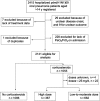Effect of low-to-moderate-dose corticosteroids on mortality of hospitalized adolescents and adults with influenza A(H1N1)pdm09 viral pneumonia
- PMID: 28464462
- PMCID: PMC5485871
- DOI: 10.1111/irv.12456
Effect of low-to-moderate-dose corticosteroids on mortality of hospitalized adolescents and adults with influenza A(H1N1)pdm09 viral pneumonia
Abstract
Background: The effect of corticosteroids on influenza A(H1N1)pdm09 viral pneumonia patients remains controversial, and the impact of dosage has never been studied.
Methods: Using data of hospitalized adolescent and adult patients with influenza A(H1N1)pdm09 viral pneumonia, prospectively collected from 407 hospitals in mainland China, the effects of low-to-moderate-dose (25-150 mg d-1 ) and high-dose (>150 mg d-1 ) corticosteroids on 30-day mortality, 60-day mortality, and nosocomial infection were assessed with multivariate Cox regression and propensity score-matched case-control analysis.
Results: In total, 2141 patients (median age: 34 years; morality rate: 15.9%) were included. Among them, 1160 (54.2%) had PaO2 /FiO2 <300 mm Hg on admission, and 1055 (49.3%) received corticosteroids therapy. Corticosteroids, without consideration of dose, did not influence either 30-day or 60-day mortality. Further analysis revealed that, as compared with the no-corticosteroid group, low-to-moderate-dose corticosteroids were related to reduced 30-day mortality (adjusted hazard ratio [aHR] 0.64 [95% CI 0.43-0.96, P=.033]). In the subgroup analysis among patients with PaO2 /FiO2 <300 mm Hg, low-to-moderate-dose corticosteroid treatment significantly reduced both 30-day mortality (aHR 0.49 [95% CI 0.32-0.77]) and 60-day mortality (aHR 0.51 [95% CI 0.33-0.78]), while high-dose corticosteroid therapy yielded no difference. For patients with PaO2 /FiO2 ≥300 mm Hg, corticosteroids (irrespective of dose) showed no benefit and even increased 60-day mortality (aHR 3.02 [95% CI 1.06-8.58]). Results were similar in the propensity model analysis.
Conclusions: Low-to-moderate-dose corticosteroids might reduce mortality of influenza A(H1N1)pdm09 viral pneumonia patients with PaO2 /FiO2 <300 mm Hg. Mild patients with PaO2 /FiO2 ≥300 mm Hg could not benefit from corticosteroid therapy.
Keywords: corticosteroids; influenza A(H1N1)pdm09 virus; mortality; pneumonia.
© 2017 The Authors. Influenza and Other Respiratory Viruses Published by John Wiley & Sons Ltd.
Figures



References
-
- Zhao Y, Zhang YH, Denney L, et al. High levels of virus‐specific CD4+ T cells predict severe pandemic influenza A virus infection. Am J Respir Crit Care Med. 2012;186:1292‐1297. - PubMed
-
- Mauad T, Hajjar LA, Callegari GD, et al. Lung pathology in fatal novel human influenza A (H1N1) infection. Am J Respir Crit Care Med. 2010;181:72‐79. - PubMed
Publication types
MeSH terms
Substances
LinkOut - more resources
Full Text Sources
Other Literature Sources
Medical
Molecular Biology Databases

